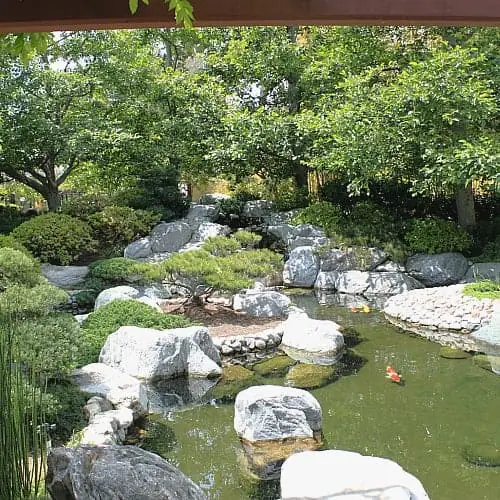
While all marginal plants provide a host of benefits for ponds, shrubs, due to their woody nature, tend to be fairly hardy, and their woody roots are adept at preventing soil erosion and reducing runoff into your pond. They also provide quite valuable habitat for many types of birds, as their woody branches are much sturdier and greater in number than those of herbaceous marginals (such as flowers).
In this article, we’re going to explore some of the best shrubs to plant marginally around pond edges, either directly in some water or in soil near the water. We’re going to focus primarily on species that can be found in nature, as opposed to hybrids that have been bred by people. We’ll include a disclaimer below each species to indicate native range, and potential invasive status if applicable.
Planting shrubs that are native to your area provides even more benefits, as they will be well-suited to your climate, and the native birds, amphibians, insects, and mammals that are around will already be familiar with these species and better able to enjoy the habitat and food that they provide without the adverse effects that an invasive species would present. A quick online search can help you find out if a plant is native or illegal/invasive in your region.
Evergreen/Semi-Evergreen Shrubs for Pond Edges
1) Juniper (Juniperus species)
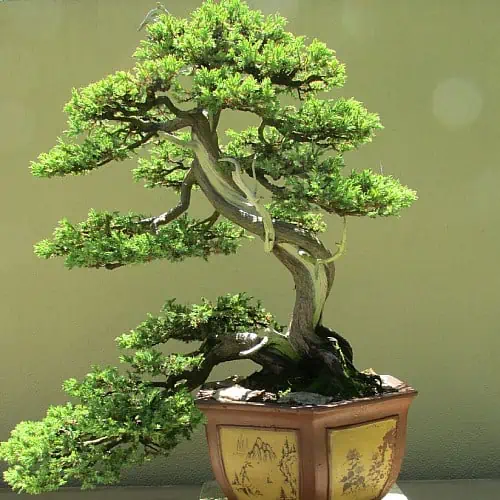
If you live in a mountainous or drier area that requires a more hardy plant, members of the juniper genus may be better suited for your fish pond. Members of Juniperus can easily add some exotic-looking character without actually using an exotic tree (depending on your location and the species you choose).
You can choose between about 60 species, from the bonsai or shrub junipers that are smaller (typically less than 5 feet tall) and better suited for the purposes of this article, to 15 to 20 foot tall weeping junipers that will create a similar effect as weeping willows but on a much smaller scale. Junipers reproduce via small, attractive blue-ish berries on the female portions of the plant that can be picked and used in spices, jams, and baking, while the male portions of the plant produce very small cone-like structures. The blue berries and evergreen leaves add some vibrant color during the winter months, in addition to giving off a pleasant, distinct scent.
These berries produce a vital food source for birds in the cold winters (if you live in a zone that experiences winter). Bluebirds, grosbeaks, partridges, and wild turkey alike all dine on these nutrient-rich little berries whenever they can find them, while juniper’s dense branches provide valuable cover. An added bonus is that they’re not only non-toxic to fish, but your fish will actually gain some valuable nutrients from them if they happen to fall into the water.
2) Camellia/Stewartia (Camellia & Stewartia species)
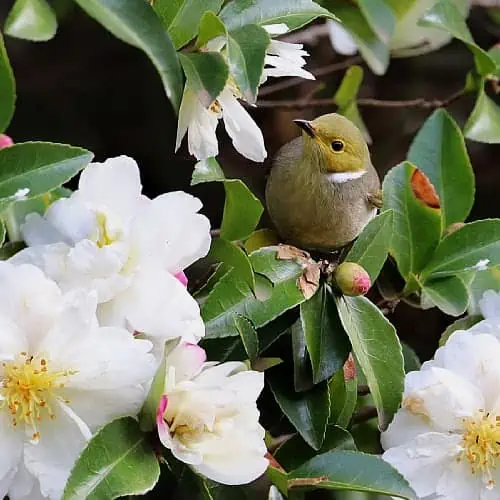
Depending on which taxonomist you ask, there are between 80 and 280 species within the Camellia genus. This, combined with many varieties having gorgeous flowers and hardy evergreen leaves, have made camellias of all kinds very popular garden plants worldwide.
If you live in the US and are seeking a very similar, but native, plant, you should check out Stewartia malacodendron (silky camellia) and Stewartia ovata (mountain camellia). Stewartias are quite closely related to camellias. There are no known camellia or stewartia species native to the UK, but these non-aggressive plants can still be responsibly grown there.
These evergreen, flowering shrubs are a wonderful way to add some pollinator power and beauty in the summer and deep green color in the winter to your pond garden. The most commonly grown varieties of camellia and stewartia are Stewartia pseudocamellia (formerly Camellia japonica) and Camellia sasanqua. C. sasanqua’s popularity is largely due to its propensity for showcasing its pink and white flowers in late winter, even in zones as low as 6b.
Neither of the camellia nor stewartia species mentioned here tolerate wet feet, but rather prefer well-draining, moist soil (not saturated!) that is rich (high in organic matter). Additionally, they grow and bloom best when placed in partial shade. Mountain camellia will tolerate full sun, if it’s not too hot. This means that they should be placed along dryer pond edges, ideally with afternoon shade if you live in a hot area, and far enough back that the soil does not have muddy soil. This shouldn’t be a problem if your pond has a liner that prevents the water from leeching into the soil (and vice-versa!).
Alternatively, you can simply place them in large, colorful pots for greater ease and some added color and pond garden decoration!
3) Rosemary (Salvia rosmarinus)
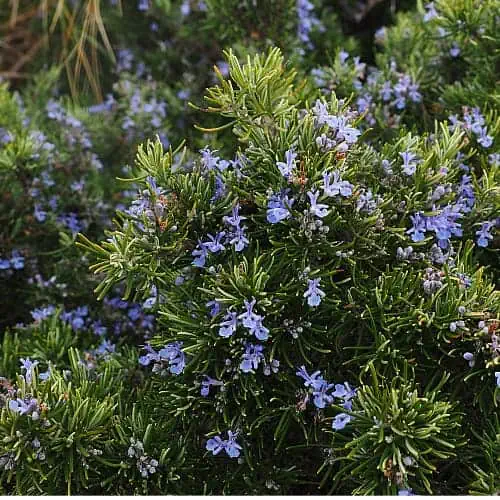
Rosemary not only smells and tastes great, it can make a wonderful, eye-catching addition to your garden pond atmosphere, too! It’s able to reach up to 5 feet in height, but is easily clipped to maintain desired height and shape (you can even make topiaries out of them!). In zones 8 and higher, it’s an evergreen shrub, but in zones 7 and below can easily be brought indoors for the winter, especially if you’ve planted it in a pot.
As rosemary is native to the Mediterranean, it prefers dry soils. In fact, rosemary is a popularly utilized plant in xeriscaping, otherwise known as landscaping and gardening in arid regions. This makes rosemary a perfect plant for your pond garden if you live in an arid location, such as the southwestern United States or drier parts of Eurasia.
Rosemary should be planted far enough away from your pond that the soil is able to dry out between watering – you will never want the soil to be moist, as this is likely to kill the rosemary. They’ll do wonderfully in a raised bed or a pot, and are best planted in the spring after all threats of frost have passed. As an added bonus, rosemary is tolerant of slight salinity due to its Mediterranean range, meaning it’ll stand up to being planted near ocean environments, as well.
4) Eve Price Viburnum (Viburnum tinus)

With its white or pink clusters of bright flowers that from winter through spring, leathery, deep green evergreen leaves, and metallic blue, black, purple, or red berries that persist through the summer and fall, eve price viburnum is a visual treat year-round.
Eve price viburnum prefers rich, moist, yet well-draining soil, and therefore should not be planted in standing water or muddy soils. Plant them a bit further back from your pond (about a meter back should be just fine, particularly if you have a pond liner). As an added bonus, this shrub is quite hardy and tolerant of short periods of drought as well as slight salinity due to being native to regions by the ocean.
Note that this species does best in hardiness zones 8 and above. If you live below this range, it may be best to plant this viburnum in a large pot so that it can be brought indoors to a heated location during the winter. Do keep in mind if you need to bring it indoors for winters that an adult height of anywhere from 6 to 12 feet can be expected.
This plant offers wildlife value to many songbirds, as they utilize the branches for cover and many enjoy eating the berries (without any known toxic side-effects). Butterflies, bees, moths, and some pollinating birds also enjoy visiting the flowers. Some report that the berries have mildly toxic properties, although this is highly contested. To be on the safe side, planting V. tinus a few feet away from your pond will not only keep the plant happy, but your fish, too.
Deciduous Shrubs for Pond Edges
5) Winterberry (Ilex verticillata)

Winterberry, also known as Michigan holly and black alder, is a species of holly that grows most readily in locations that have moist to saturated soils that are acidic, with access to either full sun or partial shade. Hardiness zones 3 through 9 suit this plant best, with it growing better in hotter zones if provided with afternoon shade in addition to making sure that soil does not dry out.
As winterberry does best in loamy, saturated soils, it’s a perfect plant to place marginally in your pond or just outside of the water on the edge, so long as it has access to ample moisture. Another great feature of this plant is that it provides year-round color – small, green-white flowers appear in the spring if they get pollinated, and are then replaced by vibrant red berries that persist through the winter and provide a wonderful contrast to snow and the pond water.
These berries provide a very valuable winter food source to birds like cardinals, juncos, chickadees, and many others, in addition to other foragers such as squirrels. They are not toxic, and therefore shouldn’t harm your fish if they happen to fall into the pond, though do take care to clean any dropped berries or foliage out regularly to maintain healthy water quality.
6) Buttonbush (Cephalanthus occidentalis)
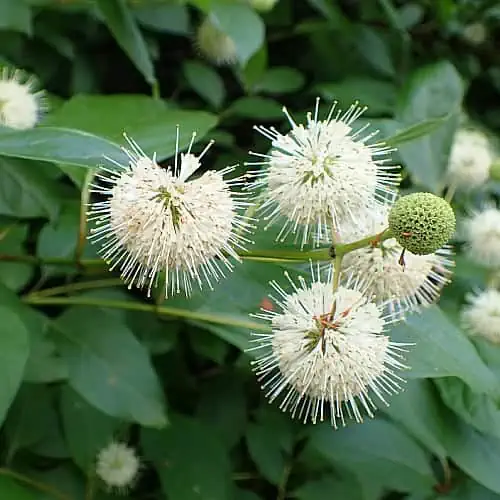
Perhaps the most unique and unusual-looking plant on this list, buttonbush is so named for its perfectly round, button-like flower heads. What looks like a single, round flower approximately one inch in diameter is actually a dense cluster of dozens of tiny, tubular flowers at the ends of each branch. These flowers readily draw in small bees, bee flies, butterflies, hawk moths, and small hummingbirds like the ruby-throated hummingbird. Additionally, waterfowl and some shorebirds (depending on where you live) enjoy eating the seeds of this non-toxic plant belonging to Rubiaceae, also known as the coffee family. Wood ducks also utilize larger, more mature buttonbush individuals for nesting and cover.
As an obligate wetland plant, buttonbush is solely found in damp locations, typically on the edges of rivers, streams, ponds, wetlands, and the like. It’s also an incredibly valuable plant to wildlife as well as ecosystem integrity, and is often utilized in wetland restoration projects to help stabilize soil erosion and provide food and cover for wildlife. Its ability to hold soil in place and attract birds and butterflies make it popular in water gardens, as well. Its fruits can stick around throughout the winter, giving it visual interest year-round.
You should know that this plant can grow up to 6 meters in height, and does best in hardiness zones 5 through 9, where it is quite winter hardy. It will grow well in flooded conditions, as well as simply moist conditions, so you could plant it directly in water marginally along your pond or further back in moist soil. It requires little to no care; just give it moisture and partial to full sunlight, and it’s happy! It will still grow in the shade, but will have far fewer flowers.
7) Dogwood (Cornus amomum/Cornus sericea)

Dogwoods are a beloved plant group due to their variety of as many as 60 species, and unique flowers. These “flowers” are not really flowers at all; dogwoods are clever, and have learned that it’s much cheaper for them to create bracts. Bracts are specialized leaves that look and even feel like flowers, but take less energy to create. Their true flowers are contained within or above the bracts, and are very small (which also saves them energy). The showy bracts draw in pollinators, and once pollinators arrive they hone in on the tiny, pollen-containing flowers.
Cornus amomum, or silky dogwood (sometimes known as swamp dogwood), can grow up to 10 to 15 feet tall, but is typically on the smaller side. The undersides of its leaves have short, silky hairs, which gives this particular species its name. Small, white bracts are topped by inconspicuous yellow flowers, which turn into clusters of colorful blue berries that can persist through winter, making them valuable to winter-dwelling birds and wildlife. Hardiness zones 5-8, moist soils (though periods of drought can be tolerated), and prefers partial to full shade but can tolerate 4 to 6 hours of full sun if it isn’t too hot or dry.
Cornus sericea, known as red-osier dogwood or red-twig dogwood, is often of particular interest to gardeners for its vibrant red stems that give wintertime a pop of color. It’s quite hardy, and tolerates damp as well as dry soils; it can be seen growing in sandy locations near woods as well as rich humus soils on the edges of wetlands, and have fantastic value in their ability to control erosion. Small white bracts and flowers emerge in the summer, turning to white berries through the autumn and winter. Hardiness zones 3 through 8 and full to partial sun work best for this hardy dogwood.
8) Spicebush (Lindera benzoin)
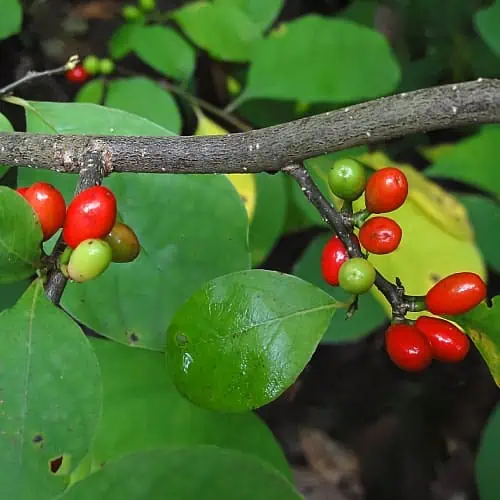
If you’re wanting to literally spice up your garden, this is the shrub for you! When disturbed, spicebush’s leaves give off a strong, spicy, sweet fragrance. In fact, another name for this small, 1-5 meter tall shrub is wild allspice! All you need to do is gently rub the leaves or new twigs to get a whiff of the uplifting scent.
Its leaves and red drupes of fat-rich berries that emerge in the fall are browsed on by over 20 species of birds in the Midwest, as well as rabbits, opossums, and deer. It’s of particular importance to the spicebush swallowtail butterfly, which eat the nectar of its yellow-green flowers, and also lays its eggs on the leaves and twigs of spicebush, as well as the wood thrush that favors its berries in the fall and winter.
In nature, it’s found in damp, rich woods, and therefore prefers moist soils and partial shade. They can tolerate full sun, so long as it’s not too dry or hot. Hardiness zones 4 through 9 suit this shrub just fine, and it will tolerate flooded conditions but not drought. With a slower growth rate, this shrub does not overtake areas and is considered a mark of ecosystem health where it’s present.
9) Swamp Rose & Dog Rose (Rosa palustris & Rosa Canina)
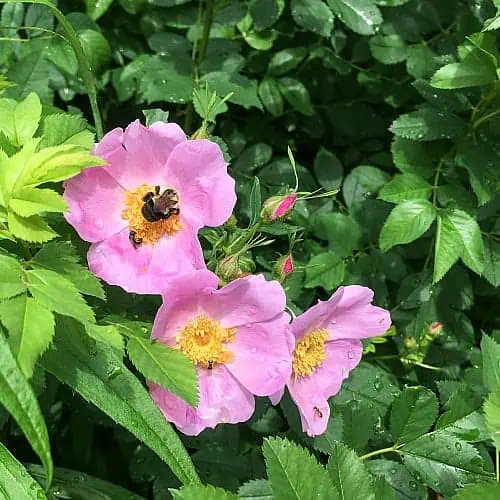
Swamp rose is a moisture-loving rose than can grow up to 6 feet, but closer to 3 is more common. It has beautiful pink blooms with contrasting yellow stamens that bloom from late spring through July, and have a sweet but not overpowering smell. These flowers are well-loved by all manner of butterflies, bees, and the occasional hummingbird. It tolerates light shade, but prefers full sun and wet conditions, growing quite well in water gardens directly in pond edges. It does not tolerate drought, and does best in hardiness zones 4 through 9.
Dog rose looks and functions quite similarly to swamp rose, but unlike its American sister is able to tolerate drought, though it still prefers moist soils. These need to be well-draining, as it won’t do well in saturated conditions like swamp rose will. Full sun to partial shade work best, and this incredibly hardy rose does well all the way down to UK hardiness zone 7! Just as with its sister species, dog rose is incredibly valuable and attractive to bees, butterflies, and other pollinators (including the occasional bat – yes, they’re important pollinators, too!).
Both of these species take anywhere from 5 years to a decade to reach their full size of up to 6 feet, and can live well beyond this range if provided with the right conditions. Be aware of their sharp, hooked thorns that are present on most rose species, and take care to plant them in locations where people or pets won’t get snagged.
10) Lilac Species (Syringa Genus)
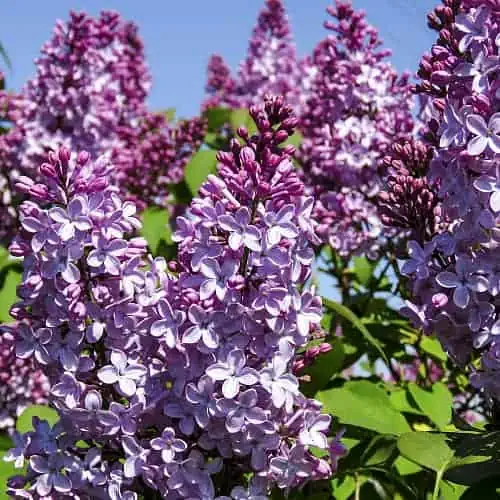
Lilacs are well-loved worldwide, and for good reason! Their beautiful, characteristic purple flowers are not only attractive to look at, but have a characteristic, floral-sweet smell that no other flower quite possesses. In fact, lilac is one of the most popular scents in the world for soaps, candles, and the like, and this smell is part of its appeal. This appeal is not lost on the natural world, for lilacs are one of the most attractive cultivated plants to all manner of butterflies, bees, moths, and other pollinators.
Their popularity means we have bred hundreds of domestic varieties, with flowers that can be lilac’s typical purple hue, or red, yellow, pink, white, or blue. Note that some species can reach up to 20 feet in height, so keep this in mind when trying to choose the variety that’s right for you. Regardless of the exact cultivar, most lilacs do best in sunny locations with moist but well-draining soil – they don’t want their feet completely wet, but should be watered regularly.
These make wonderfully beautiful, tall shrubs for the edges of your garden or hedge. They can be grown on the edge of your pond, so long as they’re not placed in standing water. If provided the right conditions, lilac will readily live for many decades, and over time will send out underground suckers that will result in a small colony or thicket over time. If you don’t wish this to happen, it’s simple to trim these suckers as growth is fairly slow.

